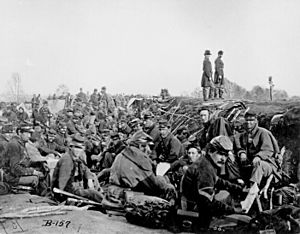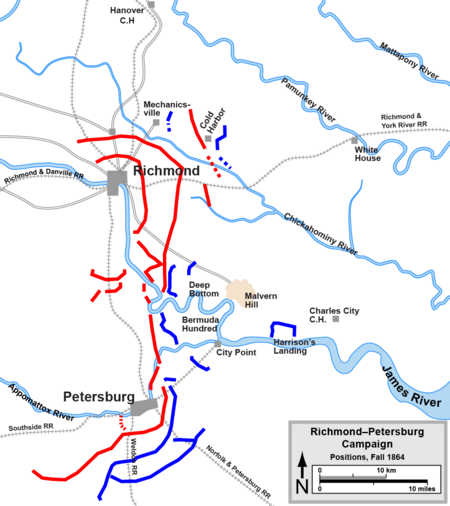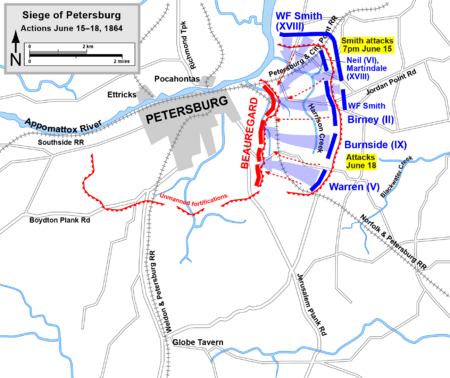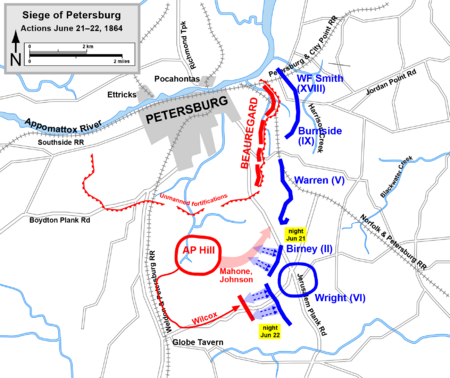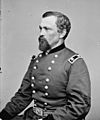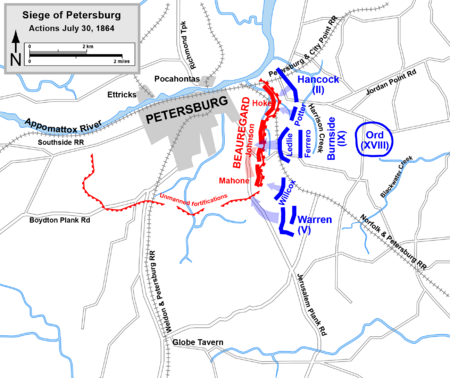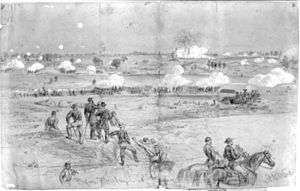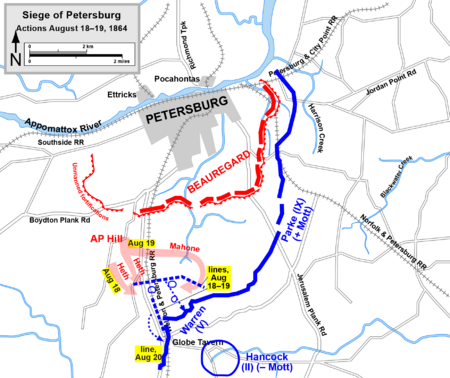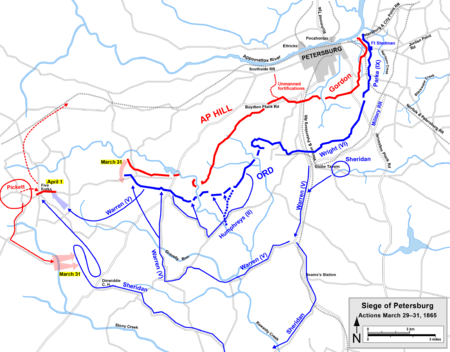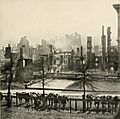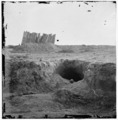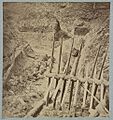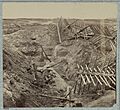Siege of Petersburg facts for kids
Quick facts for kids Siege of Petersburg |
|||||||
|---|---|---|---|---|---|---|---|
| Part of the American Civil War | |||||||
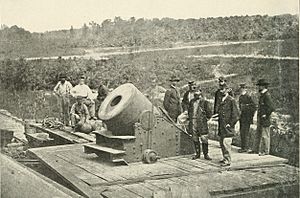 The "Dictator" siege mortar at Petersburg. In the foreground, the figure on the right is Brig. Gen. Henry J. Hunt, chief of artillery of the Army of the Potomac. |
|||||||
|
|||||||
| Belligerents | |||||||
| Commanders and leaders | |||||||
| Units involved | |||||||
| Strength | |||||||
| 125,000 | 60,000 (estimate) | ||||||
| Casualties and losses | |||||||
| 42,000 (estimate) | 28,000 (estimate) 25,000 desertions |
||||||
The Richmond–Petersburg campaign was a series of battles during the American Civil War. It lasted for nine months, from June 1864 to March 1865. This campaign is often called the Siege of Petersburg. However, it wasn't a typical siege where a city is completely surrounded. Instead, it involved a lot of trench warfare.
Union forces, led by Ulysses S. Grant, tried to capture Petersburg, Virginia. Petersburg was very important because it supplied Robert E. Lee's Confederate army and the Confederate capital, Richmond. Grant's army built long lines of trenches that stretched for over 30 miles (48 km). These trenches went from Richmond to Petersburg. Many battles were fought as the Union tried to cut off the railroads that supplied the Confederates.
Eventually, General Lee had to give up both cities in April 1865. This led to his army's retreat and surrender at Appomattox Court House. The fighting at Petersburg was a lot like the trench warfare seen later in World War I. It also involved the largest number of African-American soldiers in the war. They fought bravely and suffered many losses in battles like the Battle of the Crater.
Contents
- Why Was Petersburg So Important?
- Who Fought in the Siege?
- African Americans in the Conflict
- Early Attempts to Capture Petersburg
- Cutting the Railroads (June 21–30)
- The Battle of the Crater (July 30)
- Fighting for the Weldon Railroad
- The Beefsteak Raid (September 14–17)
- Union Attacks in Late September
- Confederate Breakout Attempt at Fort Stedman (March 25)
- What Happened Next?
- Images for kids
- Battlefield Preservation
- See also
Why Was Petersburg So Important?
How the War Was Going in 1864
In March 1864, Ulysses S. Grant became the main commander of the Union Army. He planned a big attack to put pressure on the Confederacy from many sides. President Abraham Lincoln had wanted his generals to do this from the start. Grant decided to stay with the main Union army, the Army of the Potomac, in Virginia. His goal was to fight Lee's army in a major battle. Capturing Richmond, the Confederate capital, was also a goal. Grant believed Richmond would fall once Lee's army was defeated.
Grant's plan involved several attacks. While he fought Lee in Virginia, other Union generals would attack elsewhere. For example, William T. Sherman would invade Georgia and capture Atlanta. However, many of these attacks did not go as planned. Some generals were chosen for political reasons, not military skill.
Grant's main army fought Lee in a series of bloody battles. These included the Battle of the Wilderness and the Battle of Spotsylvania Court House. Grant did not defeat Lee's army in these battles. But unlike other Union generals, he did not retreat. He kept moving his army closer to Richmond. Grant knew his larger army could handle more losses than Lee's. This idea was tested at the Battle of Cold Harbor, where Grant's army suffered heavy losses.
On June 12, Grant secretly moved his army across the James River. His new plan was to go around Richmond and capture Petersburg. Petersburg was a busy city of 18,000 people. It was a key supply center for Richmond. It had five important railroads and access to the James River. If the Union took Petersburg, Lee would not be able to defend Richmond. Grant now aimed to trap Lee's army and force them to surrender. Lee at first thought Grant was still attacking Richmond. So, he sent only a few troops to defend Petersburg.
Who Fought in the Siege?
Union Army Commanders
| Key Union Commanders |
|---|
|
At the start of the campaign, the Union forces had two main armies. The Army of the Potomac was led by George G. Meade. The Army of the James was led by Benjamin Butler.
The Union Army had many different groups of soldiers. These included:
- The II Corps
- The V Corps
- The VI Corps (which was away for some time in the Shenandoah Valley)
- The IX Corps
- The Cavalry Corps
Grant set up his main headquarters at Appomattox Manor in City Point.
Confederate Army Commanders
| Key Confederate Commanders |
|---|
|
General Robert E. Lee led the Confederate forces with his Army of Northern Virginia. General P.G.T. Beauregard commanded about 10,000 men defending Richmond. Many of Beauregard's soldiers were very young, very old, or had been wounded.
The Army of Northern Virginia had several main groups:
- The First Corps
- The Third Corps
- The Cavalry Corps
Comparing the Armies
Grant's Union armies were much larger than Lee's Confederate armies. At the start, 15,000 Union troops faced about 5,400 Confederates. By June 18, the Union had over 67,000 men, while the Confederates had 20,000.
The Union Army could easily replace soldiers and equipment. They used troops from Washington, D.C. and more African-American soldiers. By the end of the siege, Grant had 125,000 men. The Confederate army struggled to replace its losses from battles, sickness, and soldiers leaving. Sometimes, there were gaps of up to 5 feet (1.5 m) between soldiers in their trenches.
African Americans in the Conflict

During the Siege of Petersburg, African Americans played important roles on both sides. Enslaved African Americans were forced to dig trenches and do other hard labor for the Confederacy. Meanwhile, African Americans fought as soldiers for the Union in the United States Colored Troops.
African Americans in Petersburg
Before the war, Virginia had a large black population, mostly enslaved. Petersburg had a unique situation. About half its population was black, and nearly 35% of them were free. Many free black people in Petersburg had successful jobs. They worked as barbers, blacksmiths, and caterers.
Serving the Confederacy
Petersburg became a major supply hub for the Confederacy. Both free and enslaved African Americans worked for the railroads and in other war-related jobs. In 1862, they built a 10-mile (16 km) line of trenches and forts around the city.
Even after the siege began, African Americans continued to work for the Confederacy. General Lee even asked for more black laborers. In early 1865, Lee asked the Confederate Congress to allow black enslaved people to join the army in exchange for their freedom. This law was passed, but it still needed the master's permission.
Serving the Union
Nearly 187,000 African Americans served in the Union Army during the war. The largest group of these United States Colored Troops (USCT) fought at Petersburg. On June 15, a USCT division helped capture part of the Confederate defenses. Another USCT division fought in the bloody Battle of the Crater on July 30.
In December 1864, all the USCT units around Petersburg were combined. They formed the XXV Corps, which was made up entirely of black soldiers (except for officers). This was the largest black force in the war, with 9,000 to 16,000 men. USCT soldiers at Petersburg fought in six major battles. They earned 15 of the 25 Medals of Honor given to African American soldiers in the Civil War.
At City Point
African Americans also worked at the Union supply base at City Point. They served as guards, railroad workers, and laborers. They helped unload ships, move dirt, and build things. Many also worked as cooks at the army hospital.
Early Attempts to Capture Petersburg
Butler's Attack (June 9)
After the Battle of Cold Harbor, Union General Benjamin Butler realized Petersburg's defenses were weak. He wanted to make up for his past failures. Butler planned an attack with 4,500 men. Petersburg was protected by the Dimmock Line, a 10-mile (16 km) line of trenches and forts. Only 2,500 Confederates defended it.
Butler's attack started on June 9. Union infantry and cavalry tried to break through. The cavalry, led by August Kautz, attacked a fort defended by 150 militiamen. These defenders were mostly teenagers, old men, and wounded soldiers. Kautz's men pushed them back, but Confederate reinforcements arrived. Kautz withdrew. The attack failed. Butler was very angry with his generals.
Meade's Attacks (June 15–18, 1864)
Grant chose Butler's army to lead the next attack on Petersburg. On June 15, Union General Baldy Smith and his 16,000 men crossed the Appomattox River. They attacked the Dimmock Line. The Confederates had only 2,200 men defending this area. Smith's troops broke through the outer defenses. But Smith decided to wait until morning to continue.
This delay was a huge mistake. Confederate General Beauregard later wrote that Petersburg "was clearly at the mercy of the Federal commander." Beauregard used the time to bring in more troops from other areas. He even pulled soldiers from the defenses around Bermuda Hundred.
By the morning of June 16, Beauregard had about 14,000 men. But he faced 50,000 Union soldiers. Grant arrived and ordered more attacks. The Union soldiers fought hard but the Confederates resisted fiercely. They even built new defenses behind them as they retreated.
On June 17, the Union attacks continued but were not well-coordinated. Confederate engineers built new defenses a mile west of the Dimmock Line. That night, General Lee finally sent two divisions of his tired soldiers to Petersburg.
By June 18, Lee had taken command of the defenses. He had over 20,000 men. Grant had 67,000. Meade ordered a full attack. The Union troops made some progress at first, but then met the strong new Confederate lines. The fighting was very bloody. One Union regiment, the 1st Maine Heavy Artillery Regiment, lost 632 out of 900 men in one attack.
After four days of attacks with little gain, Meade ordered his army to dig in. This began the 10-month siege. The Union lost 11,386 soldiers, while the Confederates lost 4,000.
Cutting the Railroads (June 21–30)
After failing to capture Petersburg directly, Grant wanted to cut off the railroads. These railroads supplied Petersburg and Richmond. He planned a cavalry raid and also sent infantry to attack the Weldon Railroad.
Jerusalem Plank Road (June 21–23)
On June 21, Union troops moved towards the Weldon Railroad. A gap opened between two Union groups. Confederate General William Mahone saw this gap. He had been a railroad engineer and knew the area well. On June 22, Mahone's men attacked the Union from behind, surprising them. The Union lines broke, and many soldiers ran.
The Union troops regrouped. On June 23, they tried to retake the lost ground. They managed to destroy about half a mile of track. But a larger Confederate force attacked them and drove them away. The Confederates kept control of the Weldon Railroad. The Union lines were stretched further west. The Union lost 2,962 men, and the Confederates lost 572.
Wilson–Kautz Raid (June 22 – July 1)
| Commanders of the Wilson–Kautz Raid |
|---|
|
At the same time, Union Generals James H. Wilson and August Kautz led a cavalry raid. Their goal was to destroy railroads south and southwest of Petersburg. On June 22, their 3,300 men began destroying tracks. They destroyed about 30 miles (50 km) of the South Side Railroad.
On June 25, they reached the Staunton River Bridge. About 1,000 Confederate "Old Men and Boys" (Home Guard) defended the bridge. Kautz's men attacked but could not get closer than 80 yards (73 m). The Union generals decided to turn back, leaving the bridge intact.
As they returned, Confederate cavalry pursued them. Wilson and Kautz expected to find Union infantry at Reams Station. But instead, they found Confederate infantry. In the First Battle of Ream's Station on June 29, the Confederates attacked. The Union cavalry was trapped. They burned their wagons and destroyed their cannons. They fled north, losing hundreds of men as prisoners.
The raid destroyed 60 miles (97 km) of track. It took the Confederates weeks to repair. But the Union lost 1,445 men, about a quarter of their force. Grant called the raid a "disaster."
The Battle of the Crater (July 30)
Grant wanted to end the siege quickly. A Union officer, Henry Pleasants, had a new idea. He was a mining engineer. He suggested digging a long tunnel under the Confederate lines. They would then plant explosives under a Confederate fort. If successful, Union troops could rush through the gap.
The tunnel was 511 feet (156 m) long. At the end, a 75-foot (23 m) cross-tunnel was dug. It was filled with 8,000 pounds (3,600 kg) of gunpowder. This was 20 feet (6 m) below the Confederate fort.
The Union planned for a division of United States Colored Troops (USCT) to lead the attack. They were well-trained for this specific plan. However, the day before the attack, General Meade ordered that the black troops not lead. He feared that if they failed, it would cause political problems. A white division, led by James H. Ledlie, was chosen instead. Ledlie did not prepare his men well.
At 4:44 a.m. on July 30, the explosives blew up. A huge crater was formed, 170 feet (52 m) long, 60-80 feet (18-24 m) wide, and 30 feet (9 m) deep. Hundreds of Confederate soldiers were killed instantly. Ledlie's untrained men were not ready. They waited 10 minutes before moving. Instead of going around the crater, they went down into it. There were no ladders to help them get out.
Confederate General William Mahone quickly gathered his troops. They surrounded the crater and fired down into it. Mahone called it a "turkey shoot." The Union plan had failed. Burnside sent in the USCT men, but they also got stuck in the crater. For hours, Confederate soldiers killed Union troops trapped in the crater.
Grant called it "the saddest affair I have witnessed in the war." The Union lost 3,798 men, many from the USCT. The Confederates lost about 1,500. General Burnside was removed from command.
Fighting for the Weldon Railroad
Globe Tavern (August 18–21)
Grant planned another attack on the Weldon Railroad. On August 18, Union troops reached the railroad at Globe Tavern. They began destroying the tracks. Confederates attacked, pushing the Union back. But the Union counterattacked and regained their ground.
More troops arrived on both sides. On August 19, Confederates launched a surprise attack. They found a weak spot in the Union line, causing many Union soldiers to run. But other Union divisions held firm. The fighting ended at dusk.
On August 20, the Union troops moved back to a new line of forts. On August 21, the Confederates attacked again. But the Union defenses were too strong. The attacks failed with heavy losses for the Confederates.
The Union lost 4,296 men, and the Confederates lost 1,620. The Confederates lost a key part of the Weldon Railroad. They now had to carry supplies 30 miles (48 km) by wagon. This was a problem for them. Globe Tavern was the first Union victory of the campaign.
Second Reams Station (August 25)
Grant wanted to permanently close the Weldon Railroad. He sent Winfield S. Hancock's II Corps to destroy more track. On August 22, Union troops destroyed tracks near Reams Station. They took positions in old forts built during the earlier raid.
General Lee saw this as a threat to his supply line. He also saw a chance to defeat the Union army before the presidential election. Lee ordered General A.P. Hill to attack with 8,000-10,000 men.
On August 25, the Confederates attacked the Union positions. They were driven back at first. But Confederate reinforcements arrived. The Confederate artillery shelled the Union lines. The final attack broke through the Union forts. Hancock tried to rally his men, but many fled or surrendered.
The Union lost 2,747 men, and the Confederates lost 814. The Confederates won a clear victory. But they lost a vital part of the Weldon Railroad. From then on, supplies had to be unloaded 16 miles (26 km) south of Petersburg. Then, wagons had to carry them into the city. The South Side Railroad was the only one left to supply Lee's army.
The Beefsteak Raid (September 14–17)
On September 5, a Confederate scout found a Union supply depot. It had 3,000 cattle guarded by only 120 men. General Lee suggested to Confederate General Wade Hampton that Grant's rear was open to attack.
On September 14, Hampton led about 4,000 men. They rode southwest from Petersburg. On September 16, Hampton launched a surprise attack. They met little resistance. By 8 a.m., Hampton's men were driving 2,486 cattle back to Confederate lines.
A Union cavalry force tried to stop them but failed. For days, Confederate soldiers feasted on beef. They even taunted the Union soldiers across the lines. A visitor asked Grant when he expected to starve Lee. Grant replied, "Never, if our armies continue to supply him with beef cattle."
Union Attacks in Late September
New Market Heights (September 29–30)
On September 28, General Butler's Army of the James crossed the James River. They attacked the Richmond defenses. The Union had early successes at New Market Heights and Fort Harrison. But the Confederates fought back and stopped the Union advance. Lee sent more troops to defend Richmond. As Grant expected, this weakened Lee's lines at Petersburg.
Peebles Farm (September 30 – October 2)
At the same time, Grant extended his left flank southwest of Petersburg. Union troops attacked on September 30. They captured Fort Archer and pushed the Confederates out of their lines. Confederate reinforcements arrived and slowed the Union. On October 1, the Union stopped a Confederate counterattack. On October 2, the Union advanced again. They captured Fort MacRae and extended their lines. The Union built new trenches connecting to their main lines.
Confederate Breakout Attempt at Fort Stedman (March 25)
By March 1865, Lee's army was much weaker. Many soldiers had left, and supplies were low. Grant outnumbered Lee's army greatly. Lee knew Grant was planning a big attack. So, Lee planned a surprise attack of his own. He hoped to force Grant to pull back his lines.
General John B. Gordon planned the attack on Fort Stedman. It started at 4:15 a.m. on March 25. Confederate sharpshooters and engineers pretended to be deserters. They overwhelmed Union guards and cleared obstacles. Then, three groups of 100 men stormed the Union forts.
The attack was very successful at first. Within minutes, Fort Stedman and nearby batteries were captured. This opened a gap nearly 1,000 feet (300 m) long in the Union line. Gordon hoped to push all the way to City Point.
But Gordon's attack soon stalled. His small groups of men got lost in the Union rear. Many stopped to eat captured Union food. Meanwhile, the main Union defense force quickly got ready. General John G. Parke ordered his reserve division to close the gap. By 7:30 a.m., Union troops had surrounded the Confederate breakthrough. Union artillery fired heavily on the captured forts.
By 7:45 a.m., 4,000 Union troops counterattacked. They caused heavy losses to the retreating Confederates. The attack on Fort Stedman failed. Lee had weakened his own right flank to make this attack. Union forces then attacked there, capturing Confederate picket lines. This set the stage for Grant's final breakthrough.
The Union lost 1,044 men at Fort Stedman. The Confederates lost a much heavier 4,000 men. This battle was Lee's last chance to break the Union lines. After it failed, his defeat was only a matter of time.
What Happened Next?
After nearly 10 months of siege, the loss at Fort Stedman was a huge blow to Lee's army. It led to the Confederate defeat at Battle of Five Forks on April 1. Then, on April 2, the Union broke through Petersburg's defenses. Petersburg surrendered at dawn on April 3, and Richmond fell that same evening.
After his victory at Five Forks, Grant ordered a huge attack along the entire Confederate line on April 2. Union troops broke through the defenses. General A.P. Hill was killed trying to rally his men. This allowed Lee to pull his forces out of Petersburg and Richmond that night. He tried to meet up with other Confederate forces in North Carolina. But the Appomattox Campaign ended with Lee's surrender to Grant on April 9 at Appomattox Court House.
The Richmond–Petersburg campaign was very costly for both sides. The first attacks on Petersburg in June 1864 caused 11,386 Union casualties. The Confederates lost about 4,000. The entire siege, ending with Fort Stedman, resulted in about 42,000 Union casualties and 28,000 Confederate casualties.
Images for kids
Battlefield Preservation
Many historic sites and battlegrounds from the Siege of Petersburg are preserved today. The Petersburg National Battlefield is managed by the National Park Service. It includes 13 different sites that you can visit on a 33-mile (53 km) driving tour. Key parts of the park are Grant's headquarters at City Point, the Crater battlefield, and the Five Forks battlefield.
Another important site is Pamplin Historical Park. This private park preserves the "Breakthrough" battlefield where the Union made its final push. The American Battlefield Trust has also helped save over 130 acres (0.53 km2) of battlefield land. This includes the spot where Confederate General A.P. Hill was killed.
See also
 In Spanish: Campaña de Petersburg para niños
In Spanish: Campaña de Petersburg para niños


